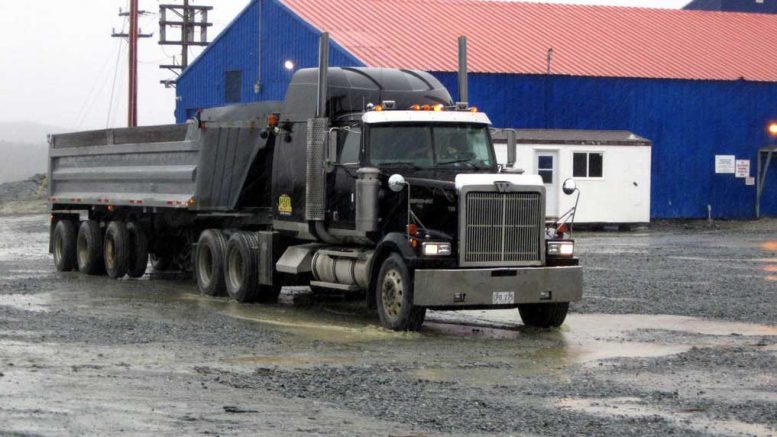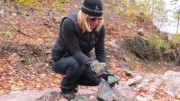DEER LAKE, NEWFOUNDLAND AND LABRADOR — “Zero degrees and no wind, not bad for the middle of January,” Norman Williams, president and CEO of Rambler Metals and Mining (TSXV: RAB; LON-AIM: RMM) says cheerfully on an early morning drive to the company’s Ming copper-gold mine in northwestern Newfoundland.
A few hours later, at nearly 800 metres below surface — the deepest pit stop during Williams’ two-hour tour of Ming’s underground workings — the temperature is an even balmier 18ºC.
At that depth, Williams and his group of visitors are in the heart of the mine’s 1807 zone — a copper-rich, massive sulphide portion of the orebody.
“It’s a long ways down, although we’re pretty shallow, compared to the guys in areas like Kirkland Lake,” Williams says of the 1807 zone, which has seen the lion’s share of mining activity since Rambler restarted the mine in 2011 and declared commercial production in November 2012. And it’s where exploration drilling has added to the mine’s reserves since production got underway.
What’s even more remarkable is that the 1807 zone — along with the mine’s other six zones — have never been cut off at depth, and Williams and his team at Rambler are convinced there’s a lot more copper and gold mineralization to be found.
“The mine is under-explored and there is a lot of exploration potential,” Williams says of the 1807, 1806, 1805, Ming North, Ming South, Upper Footwall and Lower Footwall zones. “We are committed to further exploration and I’m confident we’ll have success in adding resources both within and outside known ore zones.”
Ming’s total proven and probable reserves stand at 8.7 million tonnes at 1.8% copper and 0.48 gram gold per tonne, for 341.2 million lb. copper and 133,500 oz. gold.
Rambler’s Nugget Pond mill, 40 km from the mine, recovers a copper-gold concentrate that is sold to smelters. The mill has a conventional crushing, grinding and flotation circuit.
If Williams seems particularly chipper these days, it’s because he and his team are closing in on the prize: a throughput rate of 1,250 metric tonnes per day in the next six months, up from the current 900 tonnes per day, and well above the 650-tonne-per-day rate when the mine reopened.
Meeting the mid-year target — which seems within the company’s grasp — is the objective of Rambler’s fully funded, $20-million second-phase expansion effort.
If all goes according to plan, the mine — 17 km east of the town of Baie Verte on the north-central coast of Newfoundland — will produce between 5,100 and 5,800 tonnes copper this year, which is an increase from the 4,174 tonnes copper it churned out in 2016.
Over the next two years, Rambler plans to lift Ming’s annual copper output to 7,258 tonnes, plus associated gold and silver by-products. (Gold production this year is expected between 4,400 and 5,100 oz., down from 6,132 oz. in 2016.)
“Once we get to full production at 1,250 tonnes per day at current copper prices, we’d have $6 million to $8 million in free cash flow, and up to $15 million in earnings before interest, taxes, depreciation and amortization,” he says.
Copper is trading at US$2.72 per lb. — the first time it has reached that level since June 2015.
“The timing feels right,” Williams says. “Copper is set to rebound in the next few years, so the timing couldn’t have been better from the expansion point of view.”
The phase-two expansion is being funded by an equity investment from CE Mining Fund II, based in the Cayman Islands and advised by private equity firm Plinian Capital.
In June 2016, CE Mining Fund II acquired 63% of Rambler’s outstanding shares (priced at £0.04, or 7.4¢ per share) in a deal valued at £10.5 million ($19.1 million at the time).
Under the agreement, another 200 million warrants were exercisable within two years at £0.05, or 9.2¢ apiece. If exercised in full, the entire financing package would gross £20.5 million ($37.7 million) and result in CEII owning 75.1% of the company.
“It was a great pat on the back for the entire team when you have a group like CEII come in and say they want to be part of it,” says Williams, adding that the relationship developed after Rambler was introduced to Plinian in October 2015.
In February CEII exercised 70% of those options, funnelling another $10.5 million into the company.
After the latest investment on Feb. 6, Asa Bridle, a research analyst who follows Rambler for Cantor Fitzgerald in London, raised his target price on Rambler to £0.14 per share from £0.12.
Since CEII’s financing announced in June 2016, when the company’s shares were trading at £0.04 apiece, Rambler’s share price has surged 215% to £0.126.
Bridle notes that the latest funds will help Rambler achieve its 1,250-tonne-per-day target by mid-year, and provide funding “for a drilling program on the Lower Footwall Zone, and complete the assessment of a possible third phase of development” at 2,000 tonnes per day.
Bridle said in a research note last year that shareholders and directors of CEII’s holding company — Brad Mills, the former CEO of Lonmin (LON: LMI) and Mark Sander, the former vice-president of strategy and planning of BHP Billiton’s (NYSE: BHP; LON: BLT) copper group — could help the company during the expansion phase, and have joined Rambler’s board as non-executives.
The CEII-Plinian group “has been active in compiling mineral assets around the world across the precious metals, base metals, bulks and agri-product subsectors,” Bridle adds, reasoning that Rambler “should benefit not only from the significant cash injection the group has made, but also from “the team’s experience in the copper-gold space,” he added, “combined with their track record in mine building, project expansions and optimizations.”
The CEII-Plinian group’s portfolio, according to Bridle, includes Circum Minerals, a private company that owns the Danakil potash project in northeastern Ethiopia; Consolidated Nickel Mines, a private company partnered with China’s Jinchuan to restart the Munali nickel mine in southern Zambia; Helio Resource (TSXV: HRC), a gold explorer focused on southern Africa; Mandalay Resources (TSX: MND), which owns mines and projects across Australia, Chile and Sweden; and West African Minerals (LON: WAFM), an iron ore development company.
If Rambler’s board decides to move into a third expansion phase, which would involve rehabilitating a disabled shaft to cut haulage costs and provide more capacity, introducing a commercial dense media separation (DMS) unit and buying another ball mill, CEII could provide more funding by exercising its remaining warrants or offering more funds.
Incorporating DMS — a processing technology that would concentrate ore before it reaches Rambler’s Nugget Pond mill — would remove the waste significantly and lower cash costs. Williams says the concept is to drive mine throughput up to 2,000 tonnes per day and mill throughput to 1,500 tonnes per day, in a phase-three expansion.
Rambler has already started DMS tests at a trial plant on a batch of low-grade ore, and announced in January that the tests showed an increase in grade. About 2,200 tonnes of run-of-mine, low-grade material (grading 0.8% copper) was processed last year and yielded 1,457 tonnes of plant feed material with 1.14% copper — an increase in grade of 1.4 times with the pre-concentration step. Copper recoveries in the DMS pilot plant averaged 93.6% of the total contained copper before milling.
“We’re pretty pleased with the results,” Williams says. “This is really what drove CE Mining. The upside is pretty phenomenal, and that’s what we’re working towards. We want to demonstrate it over the next 16 months. Rejecting the waste is a critical step in this process.
“CEII saw tremendous value in phase two and were extremely happy with the prefeasibility study,” Williams continues. “But what they’re really interested in doing is taking on the DMS and shaft … we would like to have the shaft opportunity in play by 2019–2020, and similar for the DMS. That’s what we’re working on in the background now, to drive us and the board to a decision on phase three later this year.”
In a phase three scenario, throughput at Ming’s mill would climb from 1,250 tonnes per day to 1,500 tonnes per day. (Two thousand tonnes ore would be extracted from underground, with the DMS unit stripping off 25% of the waste.)
Williams says it could cost US$20 million to rehabilitate the shaft, compared with buying a new one for US$100 million. He also says Rambler could buy a ball mill for US$5.4 million.
In the meantime, the fully funded phase-two expansion is well underway, with upgrades to the mill to handle extra tonnes from bulk-tonnage mining in Ming’s Lower Footwall Zone. The Lower Footwall Zone is being mined at 1,500 feet below surface. It has different mineralization from the main deposit and a lower grade averaging 1.5% copper.
The mineral resource estimate of the Lower Footwall Zone is 26 million tonnes grading 1.5% copper at a 1% copper cut-off. Of that resource, less than 10 million tonnes were evaluated and incorporated into the phase-two mine plan as a mineral reserve.
“We’re going purely from a massive sulphide mine to a blend into the footwall zone, and that’s how we’re going to increase our tonnage to 1,250 tonnes per day,” Williams says. “The grade is going to go down, but that’s going to be compensated by the higher tonnage that will come out of the footwall. What we’re looking at in phase two is to get C1 costs down to the US$1.70 per lb. range. Without the footwall zone, this would never have been possible.”
If phase three gets the go-ahead, cash costs should come down to US$1.50 per lb., he says.
Cantor Fitzgerald’s Bridle estimates operating costs of US$1.73 per lb. this year, falling to US$1.18 next year, versus his copper-price forecasts of US$2.48 per lb. in 2017 and US$2.58 per lb. in 2018.
While the orebody dips at 35 degrees and “isn’t an easy orebody to mine,” Williams notes, the company has used the sub-level long-hole mining method in the massive sulphide zones.
“Your ideal orebody sits more vertically,” he concedes. “But we got around that with the long-hole mining method, and we’ve had groups come up from South America because they want to see how we did that.”
Along with the Ming mine, Rambler owns 100% of the former producing Little Deer and Whales Back copper mines, and has a strategic investment in the former producing Hammerdown gold mine.
The Little Deer copper project could one day become a satellite deposit for Ming, and is just 10–15 km from the company’s Goodyear’s Cove port site, and 10 km north of Springdale.
“Little Deer-Whalesback was a former producing mine, and has 7 million tonnes indicated and inferred resources at 2% copper,” Williams says. “As time passes at Ming, we will turn our attention to drilling that asset. At some point that could provide some source of mill feed, but it’s a longer-term view — 10-plus years for sure.”
The Hammerdown gold deposit was mined by Richmont Mines B (TSX: RIC; NYSE: RIC) from 2000 to 2004, during which time 291,400 tonnes were mined and milled at a grade of 15.8 grams gold per tonne. All of the ore was processed at the Nugget Pond mill. Rambler owns an 11% stake in Hammerdown, which is owned by Maritime Resources (TSXV: MAE).
“Maritime Resources is completing a prefeasibility study on reactivating that mine,” Williams says, noting that Rambler has a 500-tonne-per-day hydrometallurgical facility that is not in use, because all material from Ming is processed in the mill’s copper-concentrate circuit.
“We have an idle gold hydromet facility, so Hammerdown could be a potential feed source,” Williams says. “But you’d have to add grinding capacity, because right now there’s only one grinding system. I’d say that could be five years out.”
In the meantime, Rambler will pursue its vision of becoming a leading mine operator in Atlantic Canada.
“I am fortunate to have a tremendous group of employees,” Williams says. “And through their continued commitment and perseverance, we’ll look to build on this success story in Atlantic Canada and abroad.”






Be the first to comment on "Site visit: Rambler on track to meet targets at Ming by mid-year"